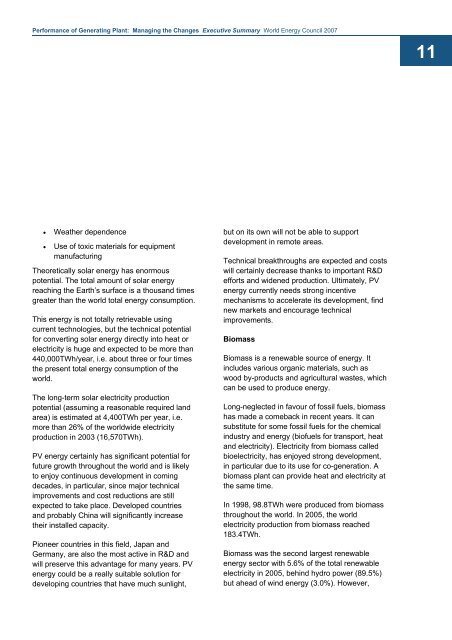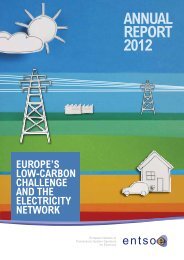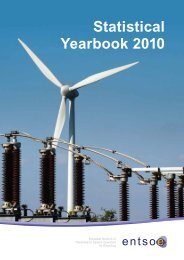Performance of Generating Plant - World Energy Council
Performance of Generating Plant - World Energy Council
Performance of Generating Plant - World Energy Council
Create successful ePaper yourself
Turn your PDF publications into a flip-book with our unique Google optimized e-Paper software.
<strong>Performance</strong> <strong>of</strong> <strong>Generating</strong> <strong>Plant</strong>: Managing the Changes Executive Summary <strong>World</strong> <strong>Energy</strong> <strong>Council</strong> 200711• Weather dependence• Use <strong>of</strong> toxic materials for equipmentmanufacturingTheoretically solar energy has enormouspotential. The total amount <strong>of</strong> solar energyreaching the Earth’s surface is a thousand timesgreater than the world total energy consumption.This energy is not totally retrievable usingcurrent technologies, but the technical potentialfor converting solar energy directly into heat orelectricity is huge and expected to be more than440,000TWh/year, i.e. about three or four timesthe present total energy consumption <strong>of</strong> theworld.The long-term solar electricity productionpotential (assuming a reasonable required landarea) is estimated at 4,400TWh per year, i.e.more than 26% <strong>of</strong> the worldwide electricityproduction in 2003 (16,570TWh).PV energy certainly has significant potential forfuture growth throughout the world and is likelyto enjoy continuous development in comingdecades, in particular, since major technicalimprovements and cost reductions are stillexpected to take place. Developed countriesand probably China will significantly increasetheir installed capacity.Pioneer countries in this field, Japan andGermany, are also the most active in R&D andwill preserve this advantage for many years. PVenergy could be a really suitable solution fordeveloping countries that have much sunlight,but on its own will not be able to supportdevelopment in remote areas.Technical breakthroughs are expected and costswill certainly decrease thanks to important R&Defforts and widened production. Ultimately, PVenergy currently needs strong incentivemechanisms to accelerate its development, findnew markets and encourage technicalimprovements.BiomassBiomass is a renewable source <strong>of</strong> energy. Itincludes various organic materials, such aswood by-products and agricultural wastes, whichcan be used to produce energy.Long-neglected in favour <strong>of</strong> fossil fuels, biomasshas made a comeback in recent years. It cansubstitute for some fossil fuels for the chemicalindustry and energy (bi<strong>of</strong>uels for transport, heatand electricity). Electricity from biomass calledbioelectricity, has enjoyed strong development,in particular due to its use for co-generation. Abiomass plant can provide heat and electricity atthe same time.In 1998, 98.8TWh were produced from biomassthroughout the world. In 2005, the worldelectricity production from biomass reached183.4TWh.Biomass was the second largest renewableenergy sector with 5.6% <strong>of</strong> the total renewableelectricity in 2005, behind hydro power (89.5%)but ahead <strong>of</strong> wind energy (3.0%). However,













